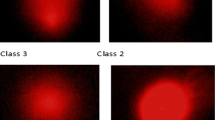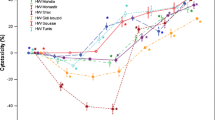Abstract
Among all the pharmaceutical drugs that contaminate the environment, antibiotics occupy an important place due to their high consumption rates in both veterinary and human medicine. The present study examined the ability of Pseudomonas putida to grow on the antibiotic wastewater, currently expanding in Tunisia, containing amoxicillin and cefadroxil. P. putida was very efficient to grow quickly in pharmaceutical wastewater (PW) and in reducing the total dissolved solids to 80.1 %. Cytotoxicity of PW, before and after biodegradation with P. putida mt-2, was evaluated in vitro, using the MTT assay, against four human tumor cell lines such as A549 (lung cell carcinoma), HCT15 (colon cell carcinoma), MCF7 (breast adenocarcinoma), and U373 (glioma cell carcinoma). The PW reduced all human cell lines viability in a dose-dependent manner. This activity was very remarkable against U373 cell line. For this reason, we have tested the genotoxicity of PW using comet assay for quantification of DNA fragmentation. In fact, PW has statistically significant (p < 0.001) influence on DNA. Indeed, the percentage of genotoxicity was 66.87 and 87.5 %, after 24 and 48 h of treatment, respectively. However, cytotoxicity and genotoxicity decreased strongly when tested the PW obtained after incubation with P. putida mt-2. Our results indicate that P. putida is a promising and improved alternative to treating industrial-scale effluent compared to current chemical treatment procedures used by the industrials.





Similar content being viewed by others
References
Ay F, Kargi F (2010) Advanced oxidation of amoxicillin by Fenton’s reagent treatment. J Hazard Mater 179:622–627
Balcioglu IA, Otker M (2003) Treatment of pharmaceutical wastewater containing antibiotics by O3 and O3/H2O2 processes. Chemosphere 50:85–95
Baquero F, Martínez J, Cantó n R (2008) Antibiotics and antibiotic resistance in water environments. Curr Opin Biotechnol 19:260–265
Ben Mansour H, Mosrati R, Ghedira K et al (2012) Bioremediation of pharmaceutical drugs Drug and Chemical Toxicology 35:235–240
Ben Mansour H, Boubaker J, Bouhlel I, Mahmoud A, Bernillon S, Ben Chibani J, Ghedira K, Chekir L (2007a) Antigenotoxic activity of crude extracts from Acacia salicina leaves. Environ Mol Mutagen 48:58–66
Ben Mansour H, Corroler D, Barillier D, Ghedira K, Chekir L, Mosrati R (2007b) Evaluation of genotoxicity and pro-oxidant effect of the acids azo-dyes Yellow 17, Violet 7 and Orange 52 and of their degradation products by Pseudomonas putida mt-2. Food Chem Toxicol 45:1670–1677
Chee-Sanford JC, Aminov RI, Krapac IJ, Garrigues-Jeanjean N, Mackie RI (2001) Occurrence and diversity of tetracycline resistance genes in lagoons and groundwater underlying two swine production facilities. Appl Environ Microbiol 67:494–502
Chelliapan S, Wilby T, Yuzir A, Sallis PJ (2011) Influence of organic loading on the performance and microbial community structure of an anaerobic stage reactor treating pharmaceutical wastewater. Desalination 271:257–264
Collins A-R, Dusinska M, Gedik CM, Stetina R (1996) Oxidative damage to DNA: do we have a reliable biomarker? Environ Heal Perspect 104:465–469
Dellai A, Deghrigue M, Clary-Laroche A et al (2012) Evaluation of antiproliferative and antiinflammatory activities of methanol extract and its fractions from the Mediterranean sponge. Cancer Cell international 12(1):18
Elmolla ES, Chaudhuri M (2009) Degradation of the antibiotics amoxicillin, ampicillin and cloxacillin in aqueous solution by the photo-Fenton process. J Hazard Mater 172:1476–1481
Franklin FCH, Bagdasarian M, Bagdasarian MM, Timmes KN (1981) Molecular and functional analysis of the TOL plasmid pWWO from Pseudomonas putida and cloning of genes for the entire regulated aromatic ring meta cleavage pathway. Proc Natl Acad Sci USA 78:7458–7462
Ghalem BR, Mohamed B (2009) Antimicrobial activity evaluation of the oleoresin oil of Pistacia vera L. Afr J Pharm Pharmacol 3:92–96
Homem V, Alves A, Santos L (2010) Amoxicillin degradation at ppb levels by Fenton oxidation using design of experiments. Sci Total Environ 408:6272–6280
Kahlmeter G, Poulsen HO (2012) Antimicrobial susceptibility of Escherichia coli from community-acquired urinary tract infections in Europe: the ECO·SENS study revisited. Int J Antimicrob Agents 39:45–51
Levy SB (1998) The challenge of antibiotic resistance. Sci Am 278:46–53
Liu X, Lee J, Ji K, Takeda S, Choi K (2012) Potentials and mechanisms of genotoxicity of six pharmaceuticals frequently detected in freshwater environment. Toxicol Lett 211:70–76
Martine VL, Stephane M, Stephane L, Daniele M, Jacque R, Alain N (2008) Synthesis and antiproliferative activity of aryl- and heteroaryl-hydrazones derived from xanthone carbaldehydes. Eur J Med Chem 43:1336–1343
Mascolo G, Balest L, Cassano D, Laera G, Lopez A, Pollice A (2010) Biodegradability of pharmaceutical industrial wastewater and formation of recalcitrant organic compounds during aerobic biological treatment. Biores Technol 101:2585–2591
Meyer MT, Bumgarner JE, Varns JL, Daughtridge JV, Thurman EM, Hostetler KA (2000) Use of radioimmunoassay as a screen for antibiotics in confined animal feeding operations and confirmation by liquid chromatography/mass spectrometry. Sci Total Environ 248:181–187
Ohgaki H, Kleihues P (2009) Genetic alterations and signalling pathways in the evolution of gliomas. Cancer Sci 100:2235–2241
Putra EK, Pranowo R, Sunarso J, Indraswati N, Ismadji S (2009) Performance of activated carbon and bentonite for adsorption of amoxicillin from wastewater: mechanisms, isotherms and kinetics. Water Res 43(9):2419–2430
Radjenovic J, Petrovic M, Barceló D (2007) Analysis of pharmaceuticals in wastewater and removal using a membrane bioreactor. Anal Bioanal Chem 387:1365–1377
Robinson T, McMullan G, Marchant R, Nigam P (2001) Remediation of dyes in textile effluent: a critical review on current treatment technologies with a proposed alternative. Biore Technol 77:247
Shengnan S, Weilin G, Chunliang Y, Yanqiu L, Zhenmin M (2012) Degradation of amoxicillin in aqueous solution using sulphate radicals under ultrasound irradiation. Ultrason Sonochem 19:469–474
Scassellati-Sforzolini G, Villarini M, Moretti M, Marcarelli M, Pasquini R, Fatigoni C (1999) Antigenotoxic properties of Terminalia arjuna bark extracts. J Environ Pathol Toxicol Oncol 18:119–125
Singh NP, McCoy MT, Tice RR (1988) A simple technique for quantitation of low levels of DNA damage in individual cells. Exp Cell Res 175:184
Sirtori C, Zapata A, Oller I, Gernjak W, Aguera A, Malato S (2009) Decontamination industrial pharmaceutical wastewater by combining solar photo-Fenton and biological treatment. Water Res 43:661–668
Smart DJ, Lynch AM (2012) Evaluating the genotoxicity of topoisomerase-targeted antibiotics. Mutagenesis 27:359–365
Tekin H, Bilkay O, Ataberk SS, Balta TH, Ceribasi IH, Sanin FD (2006) Use of Fenton oxidation to improve the biodegradability of a pharmaceutical wastewater. J Hazard Mater B 136:258–265
Wang G, Wang D, Xu X, Liu L, Yang F (2012) Wet air oxidation of pretreatment of pharmaceutical wastewater by Cu(2+) and [P(x)W(m)O(y)](q-) co-catalyst system. J Hazard Mater 217–218:366–673
Williams PA, Murray K (1974) Metabolism of benzoate and the methylbenzoates by Pseudomonas putida (arvilla) mt-2: evidence for existence of a TOL plasmid. J Bacteriol 120:416–423
Zhao DY, Zhu CJ, Sun SL, Yu HF, Zhang L, Pan WY, Zhang XX, Yu HX, Gu JD, Cheng SP (2007) Toxicity of pharmaceutical wastewater on male reproductive system of Mus musculus. Toxicol Ind Heal 23:47–54
Author information
Authors and Affiliations
Corresponding author
Additional information
Responsible editor: Philippe Garrigues
Mounira Krifa and Afef Dellai have contributed equally to this work.
Rights and permissions
About this article
Cite this article
Krifa, M., Dellai, A., Bouhlel, I. et al. Human cell death in relation to DNA damage after exposure to the untreated and biologically treated pharmaceutical wastewater. Environ Sci Pollut Res 20, 3836–3842 (2013). https://doi.org/10.1007/s11356-012-1322-1
Received:
Accepted:
Published:
Issue Date:
DOI: https://doi.org/10.1007/s11356-012-1322-1




